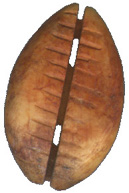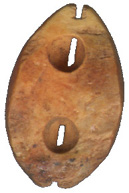| No. 0031 |  |
 |
The bone shells are the imitation cowries made from bone which outwardly resemble real shells, but the mouth wrinkles less, with ten to twenty horizontal or slant strokes filed across the surface. During the recent years, large quantities of the bone shells have been unearthed in the archaeological sites, such as in the modern provinces of Hopeh, Honan, Shantung and Shansi of China. Some of the bone shells were dyed in green or brown. Bone shells with only one hole on the reverse also existed. | ||||||||||||||||||||||||||||||||||||||||||||||||||||||||||||||||||||||||||||||||||||||||||||||||||||||||||||||||||||||||||||||||||||||||||||||||||||||||||||||||||||
| Place of origin: unknown | |||||||||||||||||||||||||||||||||||||||||||||||||||||||||||||||||||||||||||||||||||||||||||||||||||||||||||||||||||||||||||||||||||||||||||||||||||||||||||||||||||||||
| Wt. 2.2 g. | |||||||||||||||||||||||||||||||||||||||||||||||||||||||||||||||||||||||||||||||||||||||||||||||||||||||||||||||||||||||||||||||||||||||||||||||||||||||||||||||||||||||
| height: 23 mm width: 14 mm | |||||||||||||||||||||||||||||||||||||||||||||||||||||||||||||||||||||||||||||||||||||||||||||||||||||||||||||||||||||||||||||||||||||||||||||||||||||||||||||||||||||||
| Rareness E | |||||||||||||||||||||||||||||||||||||||||||||||||||||||||||||||||||||||||||||||||||||||||||||||||||||||||||||||||||||||||||||||||||||||||||||||||||||||||||||||||||||||